API documentation often becomes a developer's nightmare. Teams struggle with outdated docs, manual updates, and inconsistent formatting across projects. These challenges waste countless hours and frustrate both internal teams and external API consumers.
Learning how to use Bump.sh effectively can solve these documentation headaches. This comprehensive guide walks you through every aspect of using Bump.sh, from initial setup to advanced automation workflows that keep your API documentation perfectly synchronized.
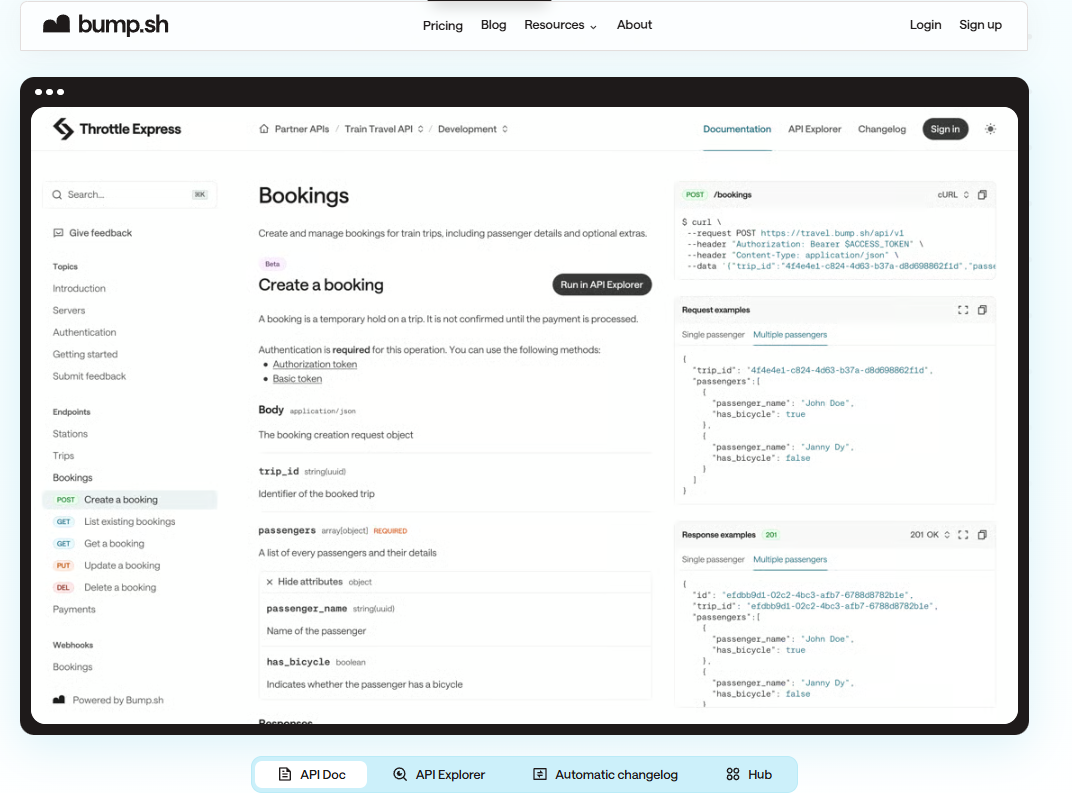
Getting Started with Bump.sh Setup
Creating Your Bump.sh Account
Begin by visiting the Bump.sh website and creating your account. The platform offers both free and paid tiers, allowing you to explore features before committing to a subscription.
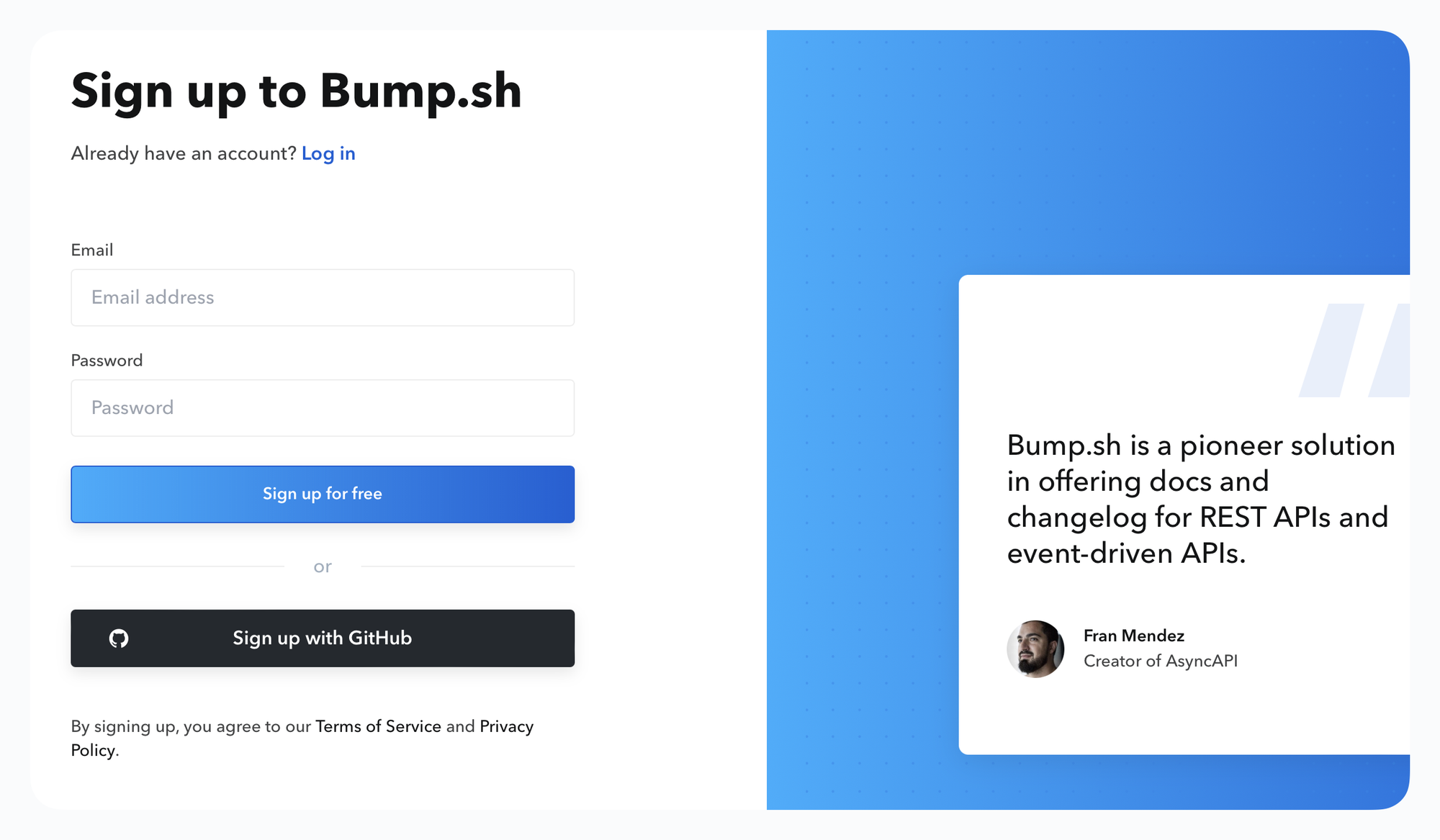
After registration, you'll access the main dashboard where all your API documentation projects live. The interface provides a clean overview of your documentation hubs, recent activity, and team collaboration features.
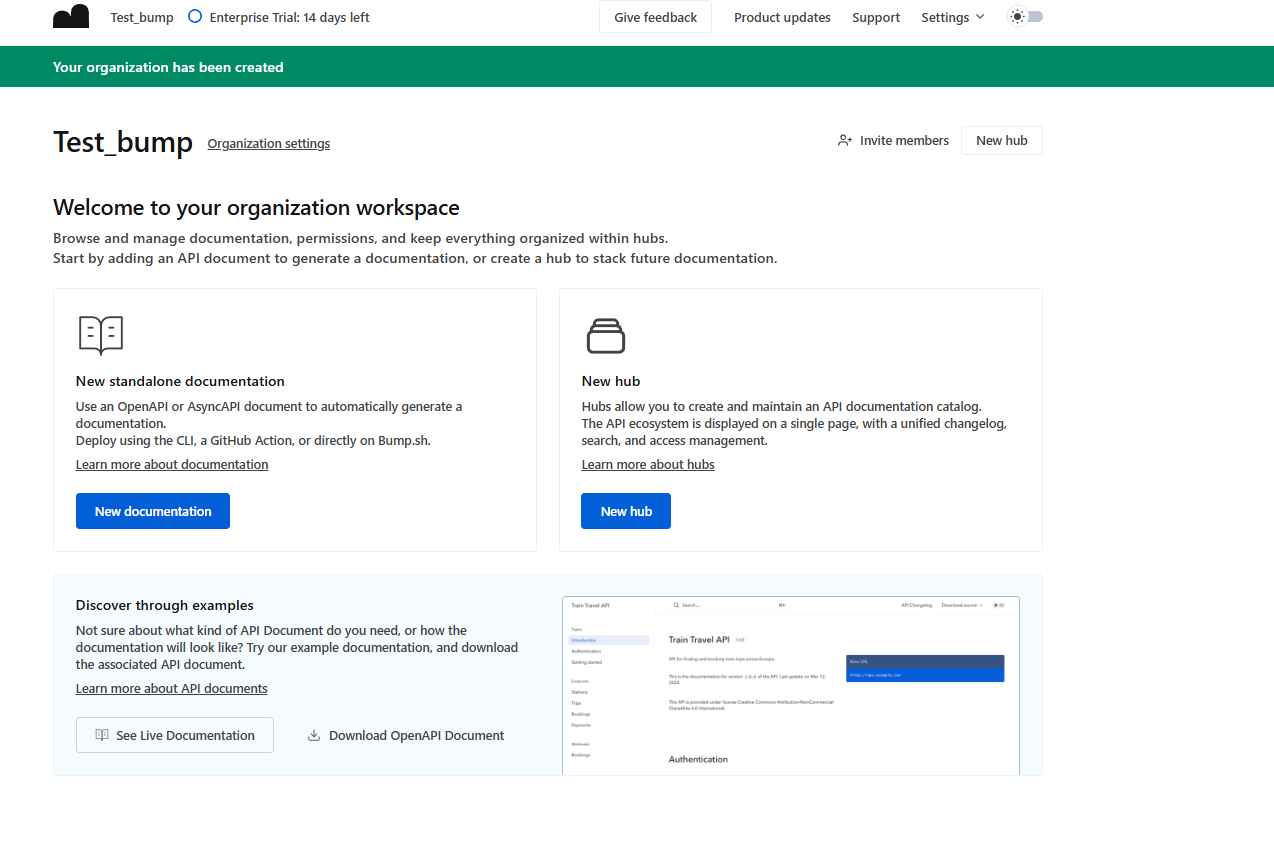
Understanding the Dashboard Interface
The Bump.sh dashboard serves as your command center for managing all API documentation projects. The main navigation includes Hubs, Validations, Diffs, and Settings sections. Hubs represent individual API documentation sites. Each hub can contain multiple versions of your API specification, allowing you to maintain documentation for different API versions simultaneously.
The Validations section shows the status of your API specification uploads, highlighting any errors or warnings that require attention. This feature helps maintain high-quality documentation by catching specification issues early.
Initial Configuration Steps
Start by configuring your organization settings. Navigate to the Settings section and update your organization name, branding preferences, and team member access permissions.
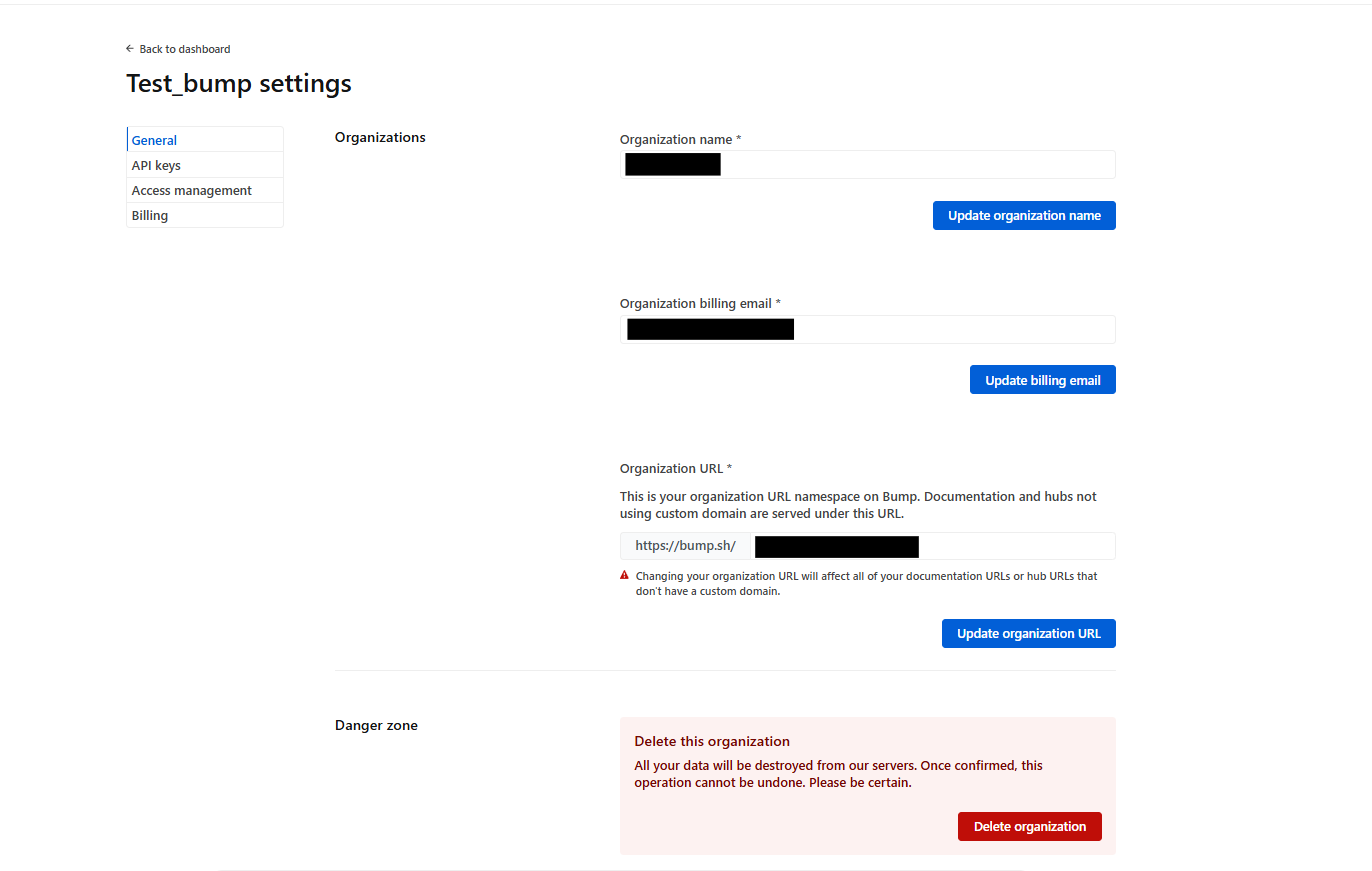
Next, establish your documentation structure by creating your first hub. Choose a descriptive name that clearly identifies the API you're documenting. This name appears in your documentation URL and helps users understand the API's purpose.
Creating Your First API Documentation Hub
Hub Setup Process
Click "Create Hub" from your dashboard to begin the setup process. You'll need to provide basic information including the hub name, description, and visibility settings.
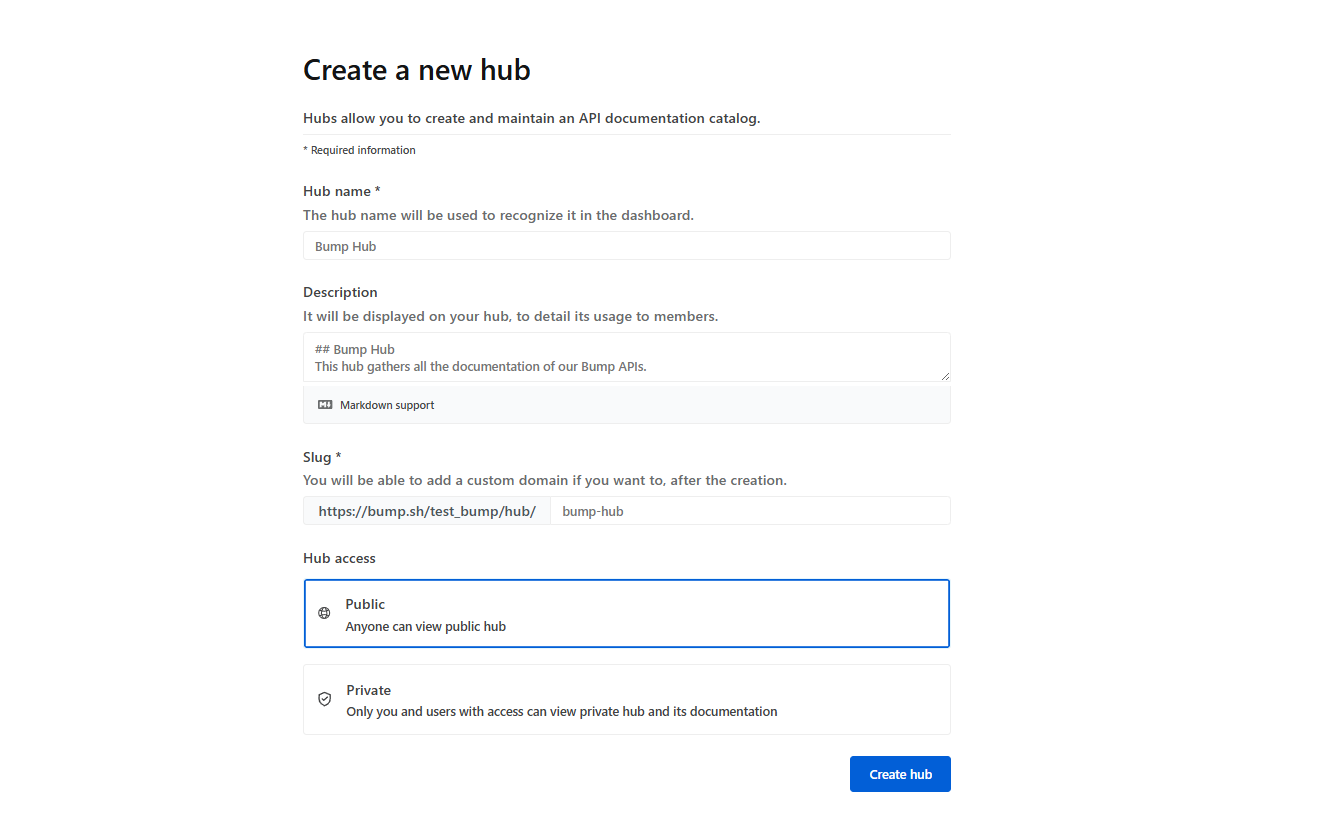
Choose between public and private visibility based on your documentation needs. Public hubs are accessible to anyone with the URL, while private hubs require authentication to access.
Additionally, configure your hub's subdomain. This creates a branded URL for your documentation that maintains consistency with your organization's domain structure.
Uploading Your API Specification
Bump.sh supports multiple specification formats including OpenAPI 3.0, OpenAPI 2.0, and AsyncAPI. Upload your specification file directly through the web interface or integrate with your version control system.
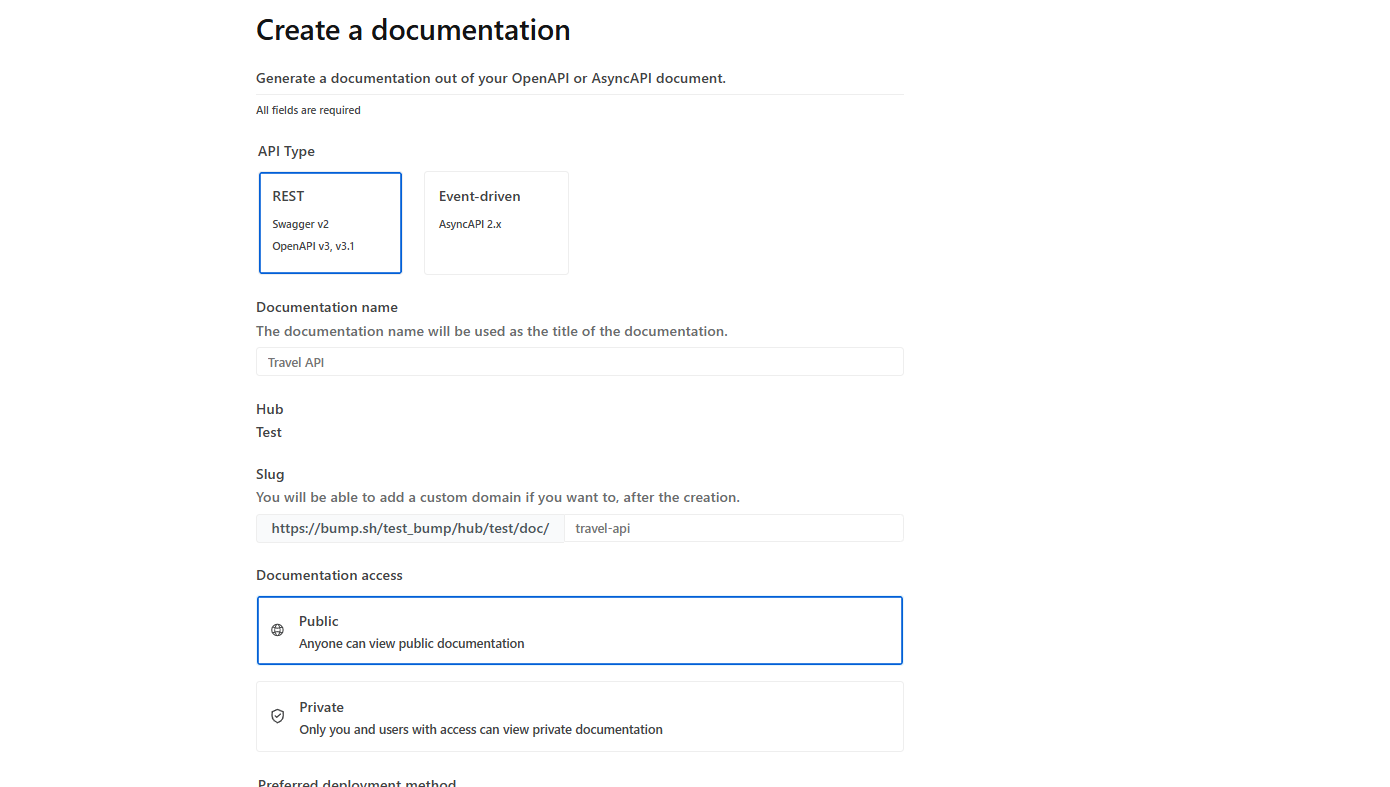
For direct uploads, use the "Deploy" button within your hub. Select your specification file and choose the version number. The platform automatically validates your specification and highlights any formatting issues.
The validation process checks for common specification errors including missing required fields, invalid data types, and broken references. Address these issues before proceeding to ensure clean documentation generation.
Integrating Bump.sh with Your Development Workflow
Version Control Integration
Connect Bump.sh to your Git repository for automated documentation updates. The platform supports GitHub, GitLab, and Bitbucket integration through webhooks and API tokens.
Generate an API token from your Bump.sh account settings. This token allows your CI/CD pipeline to push specification updates directly to your documentation hub.
Configure your repository's webhook settings to trigger Bump.sh updates whenever you merge changes to your API specification files. This automation ensures your documentation stays synchronized with your API development.
CI/CD Pipeline Configuration
Integrate Bump.sh commands into your existing CI/CD pipeline using the official CLI tool. Install the Bump CLI in your build environment and configure it with your API token and hub settings.
Create deployment scripts that run specification validation and documentation updates as part of your build process. This approach catches documentation issues early in the development cycle.
Here's a typical workflow: when developers merge API changes, the CI pipeline automatically validates the specification, updates the documentation, and notifies team members of any changes through configured webhooks.
Automated Deployment Strategies
Set up automated deployments that trigger documentation updates based on specific events. Configure different deployment strategies for development, staging, and production environments.
Use branch-based deployments to maintain separate documentation for different API versions. This approach allows you to preview documentation changes before publishing them to your main documentation site.
Additionally, implement rollback mechanisms that allow you to quickly revert to previous documentation versions if issues arise with new deployments.
Advanced Bump.sh Features and Configuration
API Diff Tracking
Bump.sh automatically tracks changes between API versions using its diff functionality. This feature highlights additions, modifications, and deletions in your API specification.
Access the diff viewer through your hub's version history. The visual diff shows exactly what changed between versions, making it easy to understand API evolution over time.
Use diff reports to communicate API changes to stakeholders and API consumers. These reports provide clear summaries of breaking changes, new features, and deprecated functionality.
Webhook Configuration for Team Notifications
Configure webhooks to send notifications when API documentation changes occur. Bump.sh supports various notification targets including Slack, Microsoft Teams, and custom webhook endpoints.
Set up different notification rules for different types of changes. For example, send immediate notifications for breaking changes while batching minor updates into daily summaries.
Customize notification content to include relevant information such as change summaries, affected endpoints, and links to the updated documentation.
Branch and Environment Management
Utilize Bump.sh's branch support to manage documentation for different development environments. Create separate documentation branches for feature development, testing, and production releases.
Configure branch-specific access controls to limit visibility of pre-release API changes. This approach maintains security while allowing team collaboration on upcoming features.
Implement promotion workflows that move documentation changes from development branches to production documentation following your release process.
Custom Domain and SSL Setup
Configure custom domains for your API documentation to maintain brand consistency. Bump.sh supports custom domain mapping with automatic SSL certificate provisioning.
Update your DNS settings to point your custom domain to Bump.sh's servers. The platform handles SSL certificate generation and renewal automatically, ensuring secure access to your documentation.
Test your custom domain configuration thoroughly, including SSL certificate validation and redirect behavior for different URL patterns.
Exploring Bump.sh Alternatives
1. Apidog - Comprehensive API Development Platform
Apidog provides the most complete alternative to Bump.sh by offering integrated API design, testing, and documentation capabilities. Unlike tools focused solely on documentation, Apidog handles the entire API development lifecycle.
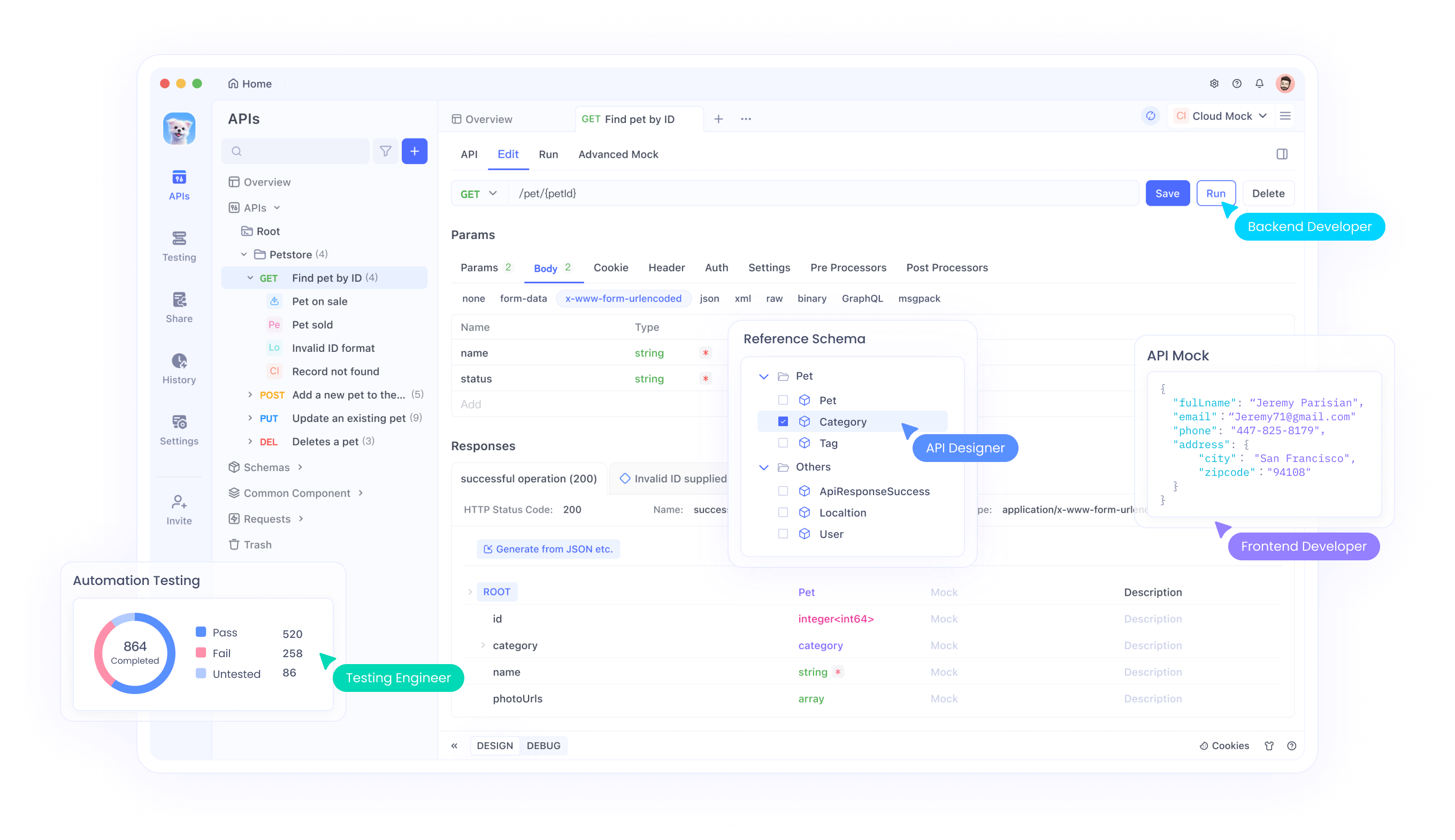
The platform features visual API design tools that generate OpenAPI specifications automatically. Teams can design APIs collaboratively, run comprehensive tests, and generate beautiful documentation without switching between different tools.
Apidog's strength lies in its unified approach. Rather than managing separate tools for design, testing, and documentation, development teams can streamline their workflow using a single platform that handles all API development needs.
2. Swagger UI - Open Source Documentation
Swagger UI remains a popular choice for teams preferring open-source solutions. The platform renders OpenAPI specifications into interactive documentation with minimal setup requirements.
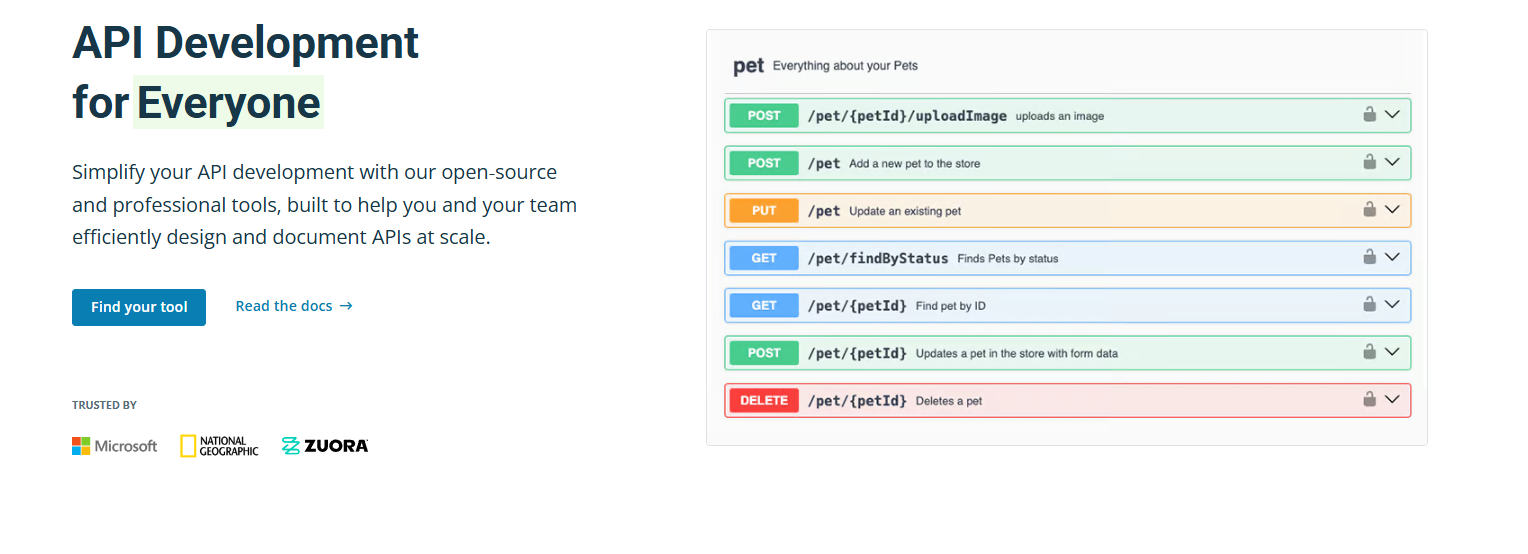
However, Swagger UI requires significant customization for production use. Teams must handle hosting, security, and advanced features independently, increasing the total cost of ownership.
3. ReadMe - Commercial Documentation Platform
ReadMe focuses specifically on creating exceptional developer documentation experiences. The platform offers advanced analytics, customization options, and developer engagement features.
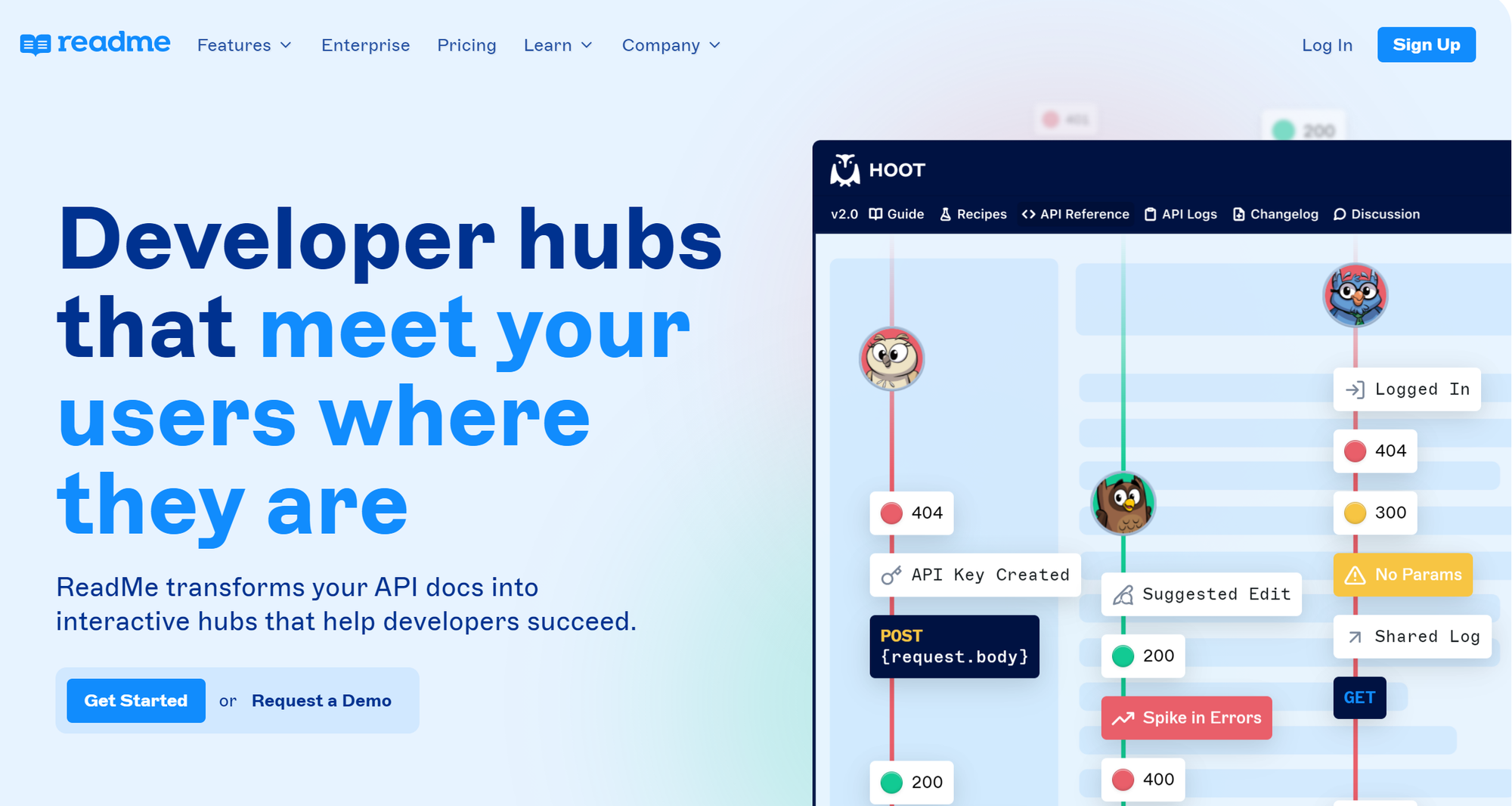
ReadMe provides sophisticated insights into how developers use your documentation, helping identify areas for improvement and optimization.
4. Stoplight - Design-First API Development
Stoplight emphasizes visual API design with comprehensive documentation generation capabilities. The platform targets teams that prefer design-first approaches to API development.
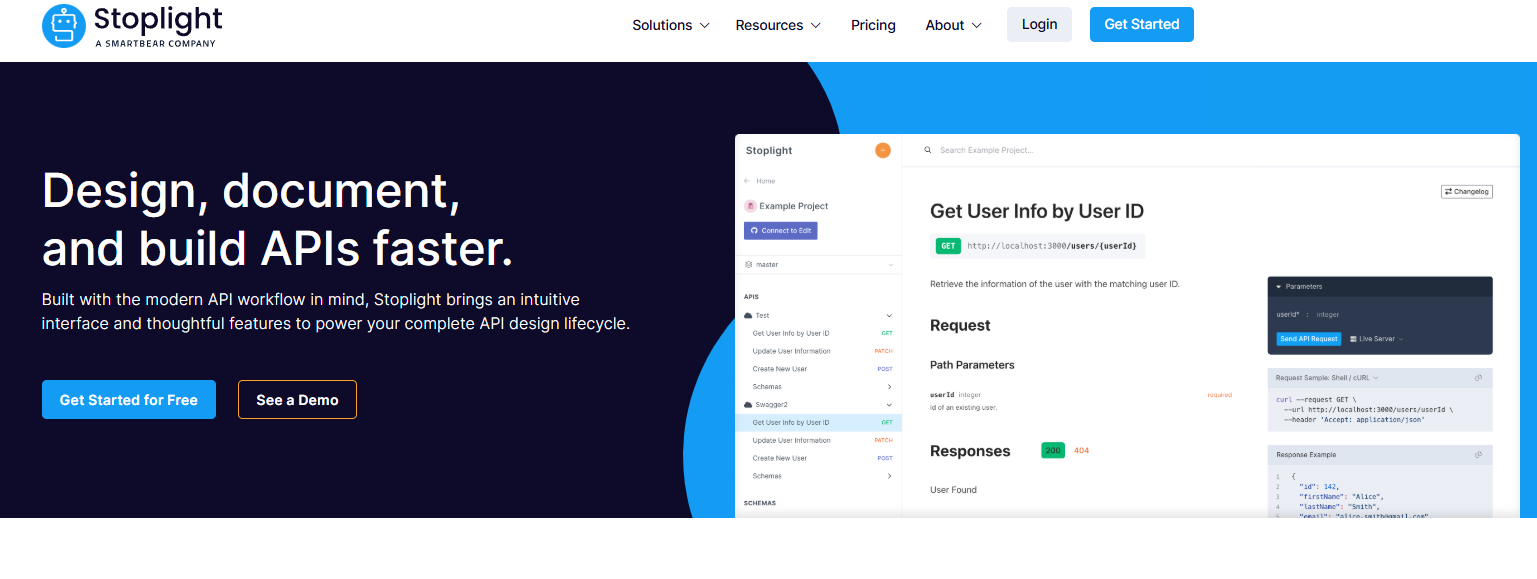
The visual editors make API design accessible to non-technical team members, promoting collaboration between developers, product managers, and designers.
5. Postman - Testing and Documentation Combined
Postman generates documentation automatically from API collections created during testing. This approach ensures documentation stays synchronized with actual API behavior.
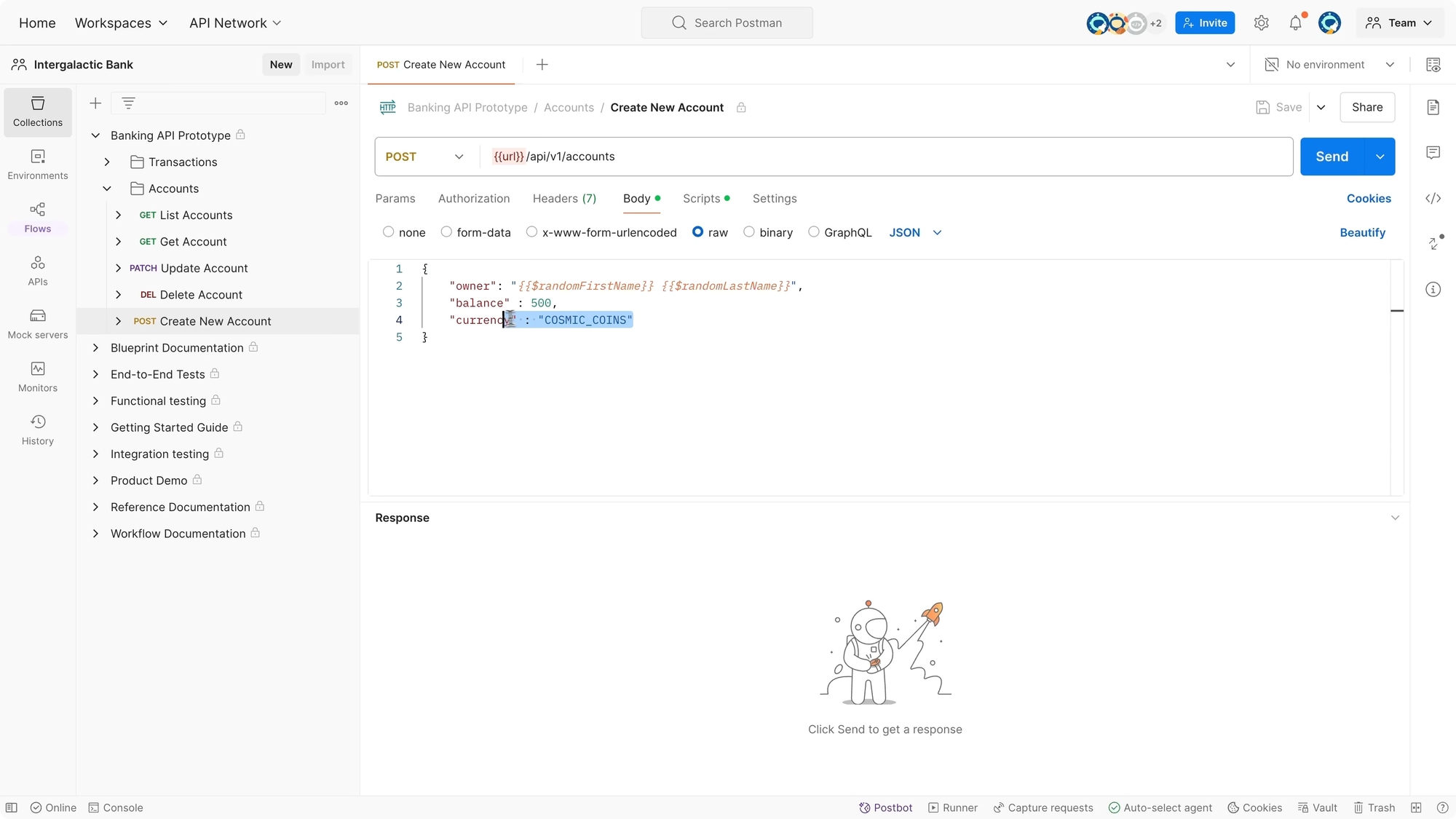
Teams already using Postman for API testing can leverage existing collections to create documentation without additional setup overhead.
Best Practices for Using Bump.sh Effectively
Specification Quality Management
Maintain high-quality API specifications to ensure excellent documentation output. Invest time in comprehensive descriptions, realistic examples, and accurate data type definitions.
Use consistent naming conventions across all your API specifications. This consistency improves the user experience and makes your documentation more professional.
Regularly validate your specifications using external tools before uploading to Bump.sh. This proactive approach prevents documentation generation issues and maintains quality standards.
Version Control Strategies
Implement semantic versioning for your API specifications to maintain clear version history. Use meaningful version numbers that communicate the nature of changes to API consumers.
Tag significant releases in your version control system to create reference points for major API versions. This practice helps track API evolution and supports rollback scenarios.
Document breaking changes clearly in your specification descriptions and release notes. Provide migration guides and deprecation timelines to help API consumers adapt to changes.
Team Collaboration Workflows
Establish clear responsibilities for API specification maintenance within your development team. Assign ownership of different API sections to specific team members or groups.
Implement review processes for specification changes similar to code review workflows. This practice ensures quality control and knowledge sharing across team members.
Use Bump.sh's collaboration features to gather feedback on documentation changes before publishing them to production documentation sites.
Performance Optimization
Optimize your API specifications for fast documentation rendering. Remove unnecessary complexity and focus on clear, concise descriptions that provide maximum value to API consumers.
Monitor your documentation site's performance using web analytics tools. Track page load times, user engagement metrics, and common user paths through your documentation.
Regularly audit your documentation for outdated information, broken links, and unclear explanations. Keep your documentation current and relevant to maintain user trust.
Troubleshooting Common Bump.sh Issues
Specification Validation Errors
Address validation errors systematically by reviewing the error messages provided by Bump.sh's validation engine. Common issues include missing required fields, invalid data types, and broken schema references.
Use external OpenAPI validation tools to identify and fix specification issues before uploading to Bump.sh. This proactive approach saves time and prevents deployment failures.
Keep detailed logs of validation errors and their solutions to build internal knowledge for your team. This documentation helps team members resolve similar issues more efficiently.
Integration Problems
Troubleshoot CI/CD integration issues by verifying API tokens, webhook configurations, and network connectivity. Test integrations in staging environments before applying changes to production workflows.
Monitor integration logs to identify patterns in deployment failures. Common issues include token expiration, network timeouts, and specification format problems.
Implement fallback mechanisms that allow manual documentation updates when automated integrations fail. This approach ensures business continuity while resolving technical issues.
Performance and Access Issues
Address documentation site performance issues by optimizing specification complexity and monitoring server response times. Large specifications may require restructuring for optimal performance.
Troubleshoot access control problems by reviewing user permissions, authentication configurations, and domain settings. Test access scenarios regularly to ensure proper functionality.
Maintain backup access methods for critical documentation sites. This preparation ensures team members can access documentation even during platform maintenance or technical issues.
Advanced Automation and Customization
Custom CSS and Branding
Enhance your documentation's visual appeal using Bump.sh's custom CSS capabilities. Create branded experiences that align with your organization's design guidelines.
Develop reusable CSS templates that can be applied across multiple documentation hubs. This approach maintains consistency while reducing maintenance overhead.
Test custom styling across different devices and browsers to ensure compatibility. Mobile-responsive designs improve accessibility for developers using various devices.
API Analytics and Monitoring
Implement analytics tracking to understand how developers interact with your API documentation. Monitor popular endpoints, common search queries, and user navigation patterns.
Use analytics insights to improve documentation quality by addressing common user questions and optimizing content organization.
Set up monitoring alerts for documentation site availability and performance. Proactive monitoring helps identify and resolve issues before they impact users.
Integration with Documentation Tools
Connect Bump.sh with other documentation tools in your ecosystem. Create workflows that synchronize content between different platforms while maintaining Bump.sh as your primary API documentation source.
Develop custom integrations using Bump.sh's API to automate complex workflows specific to your organization's needs.
Measuring Success and ROI
Key Performance Indicators
Track important metrics that demonstrate the value of your Bump.sh implementation. Monitor documentation site traffic, user engagement rates, and support ticket reduction.
Measure the time savings achieved through automated documentation updates compared to manual maintenance processes.
User Feedback and Improvement
Collect feedback from API consumers regarding documentation quality and usability. Use this feedback to continuously improve your documentation strategy.
Implement feedback collection mechanisms directly within your documentation sites. This approach provides immediate insights into user experience issues.
Conclusion and Next Steps
Mastering Bump.sh requires understanding both its core features and how to integrate it effectively into your development workflow. The platform excels at automating API documentation maintenance while providing flexibility for customization and team collaboration.
Consider your specific needs when choosing between Bump.sh and alternatives like Apidog. While Bump.sh focuses on documentation excellence, comprehensive platforms like Apidog provide broader API lifecycle management capabilities that may better serve teams seeking integrated solutions.



